If you are like me, you want to spend as little on your electric bill that you can and still live comfortably with the amenities that you are accustomed to. Ready to start saving money every month on your electric bill, starting with simple and moving to advanced?
Here are 20 things you can do that will reduce your electric bill:
- Use occupancy sensors to automatically turn off lights in unoccupied rooms
- Wash dishes at night and only when you have a full load
- Wash clothes with cold water
- Dry clothes during off-peak hours (evenings and mornings)
- Clean out your dryer vent
- Air dry clothes
- Turn back your thermostat and turn on the ceiling fans*
- Insulate Your Water Heater and hot water pipes
- Change your HVAC filters
- Pull the plug on phantom energy use
- Install low-flow shower fixtures
- Install insulated drapes for winter
- Add insulation film to windows
- Seal air leaks around windows, doors, vents and light fixtures
- Convert Your Lighting to LEDs
- Install a Humidity sensor for bathroom fans
- Supplement Your Outdoor Lighting with Solar
- Install a whole house fan
- Have your HVAC system serviced annually
- Supplement your energy needs with a solar generator
Each of these tricks offer an opportunity for you to save a little every month on your electrical bill. Together, they represent significant savings potential for you every year. Let’s break them down and see how many of these you can put into action saving energy costs in your home.
Tip #1 – Occupancy Sensors
Leaving lights on in unoccupied areas of your home is a senseless way of wasting energy and adding to the cost of your monthly electrical bill. Constantly running through the house turning off lights, however, can feel like fighting a losing battle.
Occupancy sensors are simple motion sensing devices that replace your light switch and automatically turn the lights on when you enter a room and turn them off after a predetermined time of inactivity.
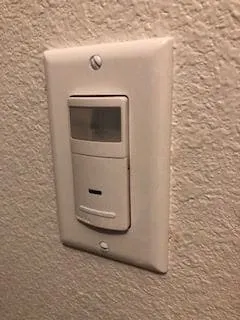
Install these occupancy sensors in all of the infrequently occupied areas of your home. Examples include:
- closets
- hallways,
- pantry
- utility room
- stairway
I installed occupancy sensors in all of these areas of my home. I looked for anywhere that I commonly found lights left on. These are areas that people pass through for a moment but forget to turn the lights off. These occupancy sensors were inexpensive and solved the problem. You can check the latest pricing on these occupancy sensors on Amazon by clicking here.
Tip #2 – Wash Dishes At Night – But Wait Until You Have A Full Load
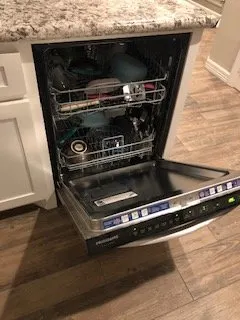
Many electrical companies charge less for energy used during off-peak hours. These hours are generally in the evening, night, and early morning. You can take advantage of this savings opportunity by loading your dishwasher but not turning it on until you go to bed.
The dishes will be clean and ready when you wake up the next morning and you’ll have the satisfaction of knowing that you kept some money in your pocket.
As a bonus, don’t run multiple cleaning cycles with partial loads. Wait until you have a full load of dirty dishes before you wash. This will reduce the number of times your dishwasher runs each month resulting in even more savings!
Tip #3 – Wash Clothes In Cold Water
Water that requires heating costs a lot of energy. You can really make a dent in your electric bill by selecting the cold water option on your washing machine. It’s a simple hack that can save you money.
Wanna save even more. Wait until off-peak hours to turn that washing machine on and your cost per kWh will be lower!
Tip #4 – Dry Clothes During Off-Peak Hours
Again, taking advantage of off-peak hours for your high energy use is a super-simple way to save money. Clothes dryers are notorious villains when it comes to energy use. Lessen the impact of drying clothes by doing this chore late in the evening or early in the morning.
Tip #5 – Clean Out Your Dryer Vent
If your dryer is running inefficiently, it’ll use more energy to get the job done. Make sure that your dryer vent is clean so that your dryer can get those clothes dried as quickly and efficiently as possible.
Tip #6 – Air Dry Clothes
If you really want to see an immediate impact on your electric bill, one of the simplest ways to do it is to air dry your clothes.
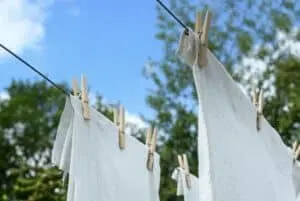
Your linens will smell fresh and clean and you will rejoice in the savings on your monthly electrical bill.
Tip #7 – Turn Back Your Thermostat
We spoil ourselves when it comes to air conditioning, don’t we? There’s nothing quite like setting that thermostat to “super chilly” and snuggling up under the covers. The problem is, we pay a toll on our electrical bill every month that we do it.
It’s important to find a balance. While there is no doubt that we can save money by turning back the thermostat and being less comfortable, no one wants to be miserable. The trick is to offset that reduction in air conditioning use by other means.
Turn on the ceiling fans*
Ceiling fans are great, low-cost cooling supplements to air conditioning but it’s important to remember that they are only effective when you are in the room. Don’t just leave the fans running throughout your home all day and night. Turn them on in the rooms where your family is going to be for a decent amount of time.
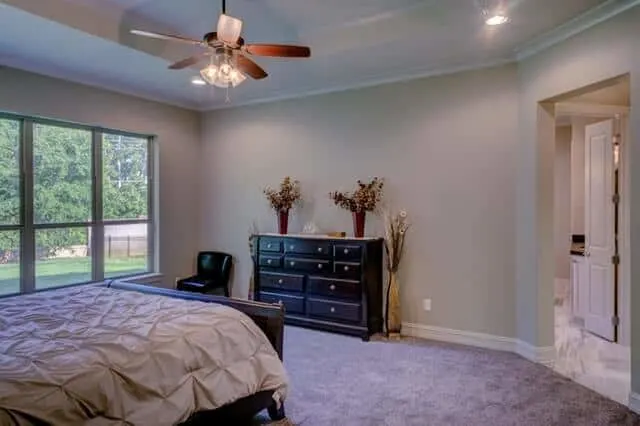
Bedrooms, for example, are great locations because the fans can be run all night and you can turn back the thermostat a bit. A family room where everyone gathers for evening television and games for a couple of hours is another great option.
If you really want to super-charge the savings of your air conditioner’s energy use, consider investing in a smart programmable thermostat. Energy Star calculates that by proper use of a programmable thermostat, a family can save around $180 annually on their electrical bill.
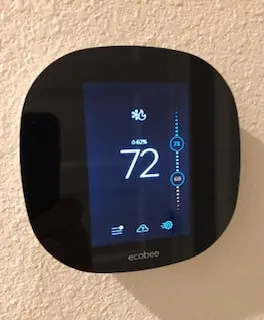
The advantage of a smart thermostat over the old programmable ones is that you can set up schedules and adjust the temperature right from your phone.
I have Ecobee smart thermostats in my home and have found that I can even set up a vacation mode for low energy use while the family is away. When we are headed back home I simply turn off vacation mode from my phone and the house is nice and comfy when we return! Click here to check the latest pricing on Amazon.
Click here for ideas on how to automate your home energy savings with devices like this.
Tip #8 – Insulate Your Water Heater and hot water pipes
Energy lost is energy wasted. You are spending money to heat water but then it sits in the water heater unused and slowly begins to cool. So that water heater goes back to work, spending your hard earned money reheating that same water. It’s crazy!
You can slow the cooling of that water and hold in the heat better by wrapping your water heater with a water heater insulation wrap. You’ll spend less money keeping the water hot each month!

You can save even more by insulating the hot water pipe that exits your water heater. It’s a low-cost, 15-minute project that can save you some money. Every little bit counts!
Tip #9 – Change Your HVAC Filters
Your central air and heating system will run more efficiently and use less energy if you keep the filters changed out regularly. Set a reminder on your phone to do this every month unless you are using a 3-month air filter. These can keep your system running efficiently while reducing the frequency of replacement.
Tip #10 – Pull The Plug On Phantom Energy Use
Take a look around your home at all the electronic devices that are plugged in right now. How many of them are actually being used right now? Not many,
This is a phenomenon known as “phantom” or “vampire” energy use. I prefer to call it “phantom energy theft” because these devices are literally stealing money from your pocket every month, drawing electricity from the grid while they are sitting idle.
According to the Department of Energy, those phantom energy thieves are costing the average homeowner over $100 per year!
Take control of these devices! Century makes a nifty and inexpensive energy saver socket that sits between your electronic device and the outlet and has an automatic timer for 15 minutes, 30 minutes, 1 hour, 2 hours, 4 hours, or 6 hours.
After the predetermined amount of time, it automatically kills the power to that device. When you need to turn the device back on you

I love devices like this. My wife is notorious for forgetting to turn off her curling iron. It not only wastes money but is a potential fire hazard. A device like this solves that kind of problem lickety split!
And all those phantom energy thieves? They are stopped in their tracks by this little device.
But what about an entertainment system where you have a television several other electronic devices plugged in? The best way to deal with those phantom energy users is with a surge protector energy saver strip like this one on Amazon. You can set automatic timers to limit the energy consumption to only those times when the devices are in use. Automatic money saving!
Tip #11 – Install Low-Flow Showerheads
Saving money doesn’t have to mean living miserably. If you love a high-pressure shower experience but don’t love all the money that you are spending to indulge, consider installing a high-efficiency low-flow showerhead. You’ll spend less money each month on water and water heating without sacrificing the experience of a high water pressure shower.
Tip #12 – Lock In The Comfort With Insulated Drapes
Upgrading your window drapes to a thermal insulated, energy-saving version can help to keep hot or cold air outside from invading your living space. This is a simple and easy energy-saving strategy.
Tip #13 – Add Insulation Film To Windows
This is a great weekend project to save money on your energy costs. Reduce energy loss through windows by adding an invisible insulating film which can increase the R-value on your windows by 90%!
Tip #14 – Seal Air Leaks
One of the simplest and most effective solutions for saving money on energy use by stopping energy loss. Windows, doors, light fixtures, HVAC vents, and outlets all allow conditioned air to escape out of your home if they are not properly sealed.
I went through my home and installed these wall plate insulation gaskets in every outlet we have on an exterior wall. I even made sure to add them in the garage.
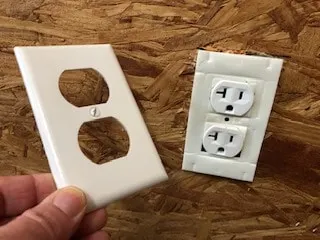
I sealed around plumbing pipes, light fixtures, and air conditioning vents with Great Stuff foam spray.
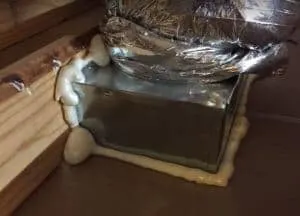
It can be a challenge to get into the attic and seal these once the insulation is in, but a simple alternative is to use caulk from the inside of the house. The goal is to simply close the seam between the vent or light fixture and the sheetrock. Click here for more information on air-sealing.
By doing this, you eliminate air leaks and ensure that your home is more energy efficient. Don’t overthink it. It’s better to do something than to do nothing when it comes to air leaks.
And don’t forget those windows and doors. Make sure you have a tight seal around them. It’s worth the time and it can really add up in savings!
Tip #15 – Make The Switch To LED Lighting
These days,
And just so you know, I practice what I preach. Every light in my home is LED, even the 40+ recessed lights throughout my home (all air sealed to prevent leaking, of course!)
Tip #16 – Install A Humidity Sensor For Bathroom Exhaust Fans
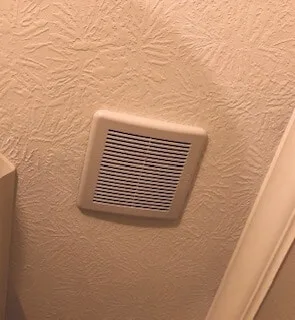
This is one of my all-time money-saving tricks.
So, you know those exhaust fans in bathrooms that are designed to remove humidity and, well, odor?
They are one of the biggest culprits of energy waste in your home!
I want you
I’ve written about this in a previous post because it is such an overlooked opportunity to save money and have a more efficient home.
Yes, exhaust fans do serve an important purpose when it comes to moisture. While taking a shower, for example, it is common for condensation to form on the walls and mirrors in a bathroom. The exhaust fan can help with this issue.
The problem with these fans is that too often people leave them running long after the condensation issue is resolved. I remember waking up in the mornings and finding that my kids had left the bathroom exhaust fan running all night.
While my air conditioner or heater was fighting to keep the house comfortable, this thing was steadily throwing that conditioned air (and money!!!) out of the house!
I solved this issue with a simple trick that I’ve never once regretted. I installed a humidity sensor switch in the bathroom.
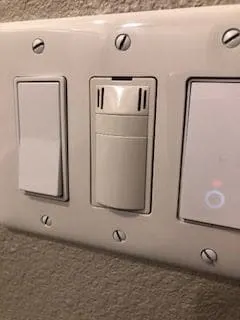
When the humidity level in the bathroom reaches a certain threshold, the exhaust fan turns on automatically. What’s really great about it though is that it also turns off automatically once the moisture level returns to normal. Well worth the money. Well worth the time to install. Definitely one of my all time favorite energy saving tips!
Tip #17 – Supplement Your Outdoor Lighting with Solar
Anytime you turn on a light, you are using energy. You can easily offset that energy use and save money month after month by supplementing your outdoor lighting with solar. I use solar lighting extensively outside my home including these amazing solar flickering torch lights!
Solar-powered security floodlights, landscape lighting, string lights, and even really nice looking accent lights can all help to illuminate your yard and provide security for your home without costing you on your electric bill.
I’ve written extensively on taking advantage of super-simple solar solutions. To learn more, read How To Get Started With Solar Power (Simple Solutions!)
Tip #18 – Install a Whole House Fan
There’s a lot of debate on the effectiveness and energy savings of a whole house fan but I can tell you that I save hundreds of dollars every year on my electric bill and I live in Texas where I can only use it for a couple of months each year (spring and fall).
If you live anywhere cooler, you stand to save much more.
There are key strategies to using a whole house fan to save money which I explained in detail in a previous post (link to that post below) but the bottom line is when weather conditions are right, we enjoy a cool breeze of fresh air through our home at a fraction of the cost of running our central air.
To learn how I save hundreds every year on my electric bill by supplementing my home cooling costs with a whole house fan, read this post.
Tip #19 – Have Your HVAC System Maintained Annually
Mechanical systems are most effective when they are running at peak performance. The only way to ensure that your central air and heating system is by using the least amount of money each month to keep your family comfortable is to have an annual maintenance check performed.
If you are handy and know your way around HVAC systems, you can do this yourself. Otherwise, hire an expert and ensure that your system isn’t using more energy than needed to keep you comfortable.
Tip #20 – Supplement Your Energy Needs With A Portable Solar Generator
Over the past few years, I have come to realize just how beneficial a portable solar generator can be in not only providing emergency power in the event of a power outage but in supplementing energy costs in the home every day.
I have had the opportunity to speak with homeowners who have implemented some really creative solutions for saving money with a portable solar generator. Ideas such as running their refrigerator or freezer, shop lighting and power tools, and dozens of other approaches.
What’s really nice about it is that these portable solar generators are much more affordable than a whole house solar system which can cost tens of thousands of dollars.
Having a way to take advantage of free energy from the sun, but doing it on a budget that you can afford, makes all the difference. Plus, if you suffer an extended power outage, you have a sustainable means of providing power to essential devices.
If you would like to learn more about how you can benefit from having a portable solar generator, be sure to read Seven Reasons Why A Solar Generator May Make Sense For You.
Conclusion
Everyone’s situation is different but we all would enjoy saving money on our electric bill each month. Not every tip here may work for you but which ones can you put into action immediately to begin saving?
Which ones are worth investing in so that you can see a return on that investment in electric bill savings month after month for years to come?
Regardless of how you choose to approach your energy savings strategy, be diligent. Keep chipping away at the savings, adding new strategies every month so that you can create a snowball effect, piling more and more savings up with each passing month.
Remember, home efficiency and energy savings is not a do-it-once-and-forget-it approach, it is about making adjustments to the way you use energy each month and ensuring that your home is as energy efficient as it can be.
To learn more about saving money on your electric bill, read Why Is My Electric Bill So High? Here’s The Answer!
All my best.
As a homeowner, I am constantly experimenting with making the structure of my house more energy-efficient, eliminating pests, and taking on DIY home improvement projects. Over the past two decades, my family has rehabbed houses and contracted new home builds and I’ve learned a lot along the way. I share my hard-learned lessons so that you can save time and money by not repeating my mistakes.

